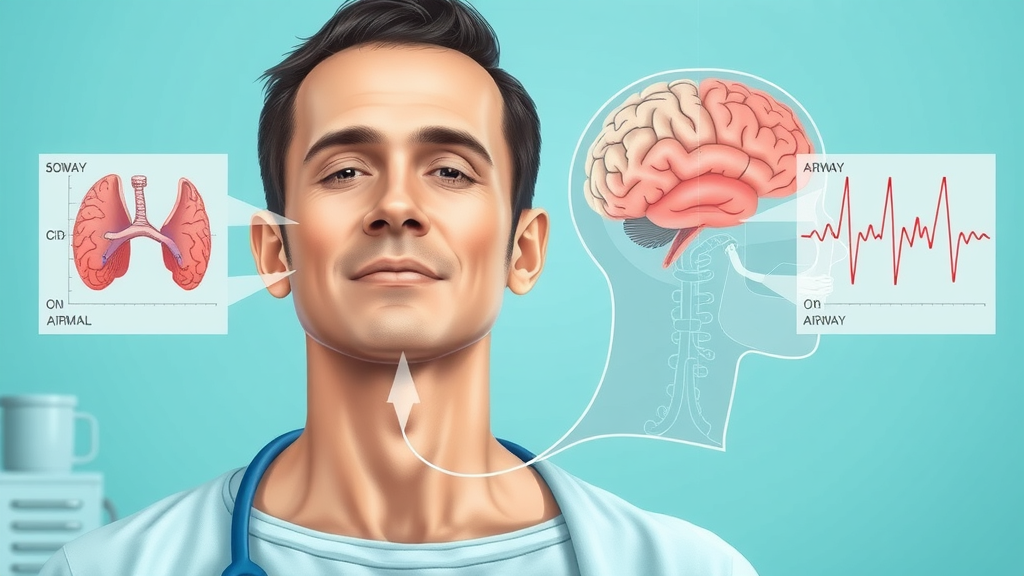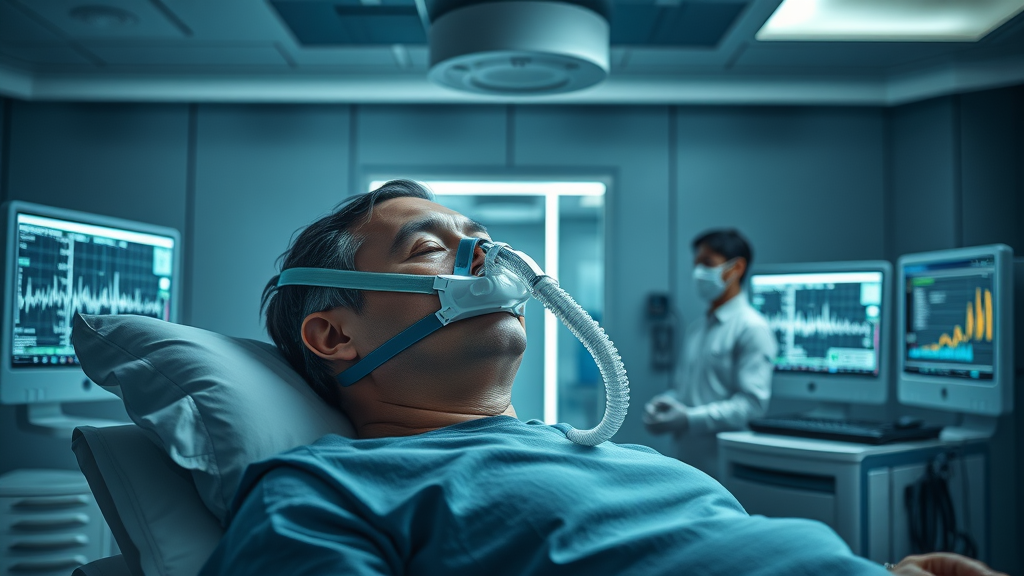Imagine drifting off to sleep, only for your body to hit “pause” on breathing—sometimes dozens or even hundreds of times each night. Here’s the shocking truth: up to 80% of people with moderate to severe sleep apnea stay undiagnosed , unknowingly putting themselves at increased risk of heart attack, stroke, and sudden death . Is sleep apnea dangerous? Yes, and understanding the urgency could mean the difference between life and death. In this comprehensive guide, we reveal the facts, symptoms, and risks you must know, alongside actionable steps to take control—before it’s too late.
Startling Sleep Apnea Facts: Why Ignoring the Risks Can Be Fatal
Sleep apnea is more than a common sleep disorder; it’s a potentially deadly health condition affecting millions worldwide. The dangers of ignoring this widespread problem are profound. Studies reveal that up to 80% of people with moderate or severe obstructive sleep apnea remain undiagnosed, silently enduring nightly interruptions in breathing—and suffering severe health consequences. Silent but relentless, sleep apnea gradually increases your risk for heart attack, stroke, and even sudden cardiac death, especially if left untreated.
The most alarming aspect? Many individuals attribute their fatigue, lack of focus, and morning headaches to “just poor sleep” or stress. Yet behind these symptoms, their bodies repeatedly stop breathing during the night, causing oxygen levels to plummet and triggering dangerous spikes in blood pressure. Over time, this constant pattern of oxygen deprivation and stress hormone surges damages the heart, blood vessels, and brain, making sleep apnea a direct threat not just to rest—but to life itself.

- Discover how sleep apnea silently threatens millions, with shocking statistics showing up to 80% of moderate to severe cases remain undiagnosed—risking heart attack, stroke, and even sudden death during sleep.
Is Sleep Apnea Dangerous? Understanding the Immediate and Long-Term Health Consequences
Is sleep apnea dangerous? Medically speaking, the answer is a resounding yes . Beyond restless nights, untreated sleep apnea leads to immediate and long-term consequences that can undermine your health and well-being. In the short term, people with sleep apnea experience drastic drops in oxygen level, interrupted sleep cycles, and surges in stress hormones. Each time your breathing pauses, your body’s fight-or-flight response is triggered, causing spikes in blood pressure and heart rate, straining your cardiovascular system—even as you sleep.
Over time, this constant internal turmoil inflicts cumulative damage. The long-term risks include an increased chance of heart attack, stroke, chronic hypertension, diabetes, and even sudden cardiac death. Untreated sleep apnea isn’t just about feeling tired during the day; it’s a ticking time bomb, putting every major organ system at risk. Recognizing both the immediate and deferred dangers underscores why diagnosis and treatment are vital.
How Obstructive Sleep Apnea and Central Sleep Apnea Differ in Risk and Severity
There are two primary types of sleep apnea: obstructive sleep apnea (OSA) and central sleep apnea (CSA) . OSA is the most common type, occurring when the muscles in the throat relax excessively, blocking the airway and causing you to stop breathing repeatedly during sleep. People with OSA experience frequent oxygen level drops and frequent awakenings, often accompanied by loud snoring and gasping for air. This form is especially dangerous because it frequently goes unnoticed, yet it can result in significant cardiovascular and systemic risks.
Central sleep apnea , while less common, is equally concerning. Rather than a blocked airway, CSA happens when the brain fails to send the right signals to the muscles that control breathing. This can lead to long pauses in breathing—sometimes without any of the typical signs like snoring—and is often associated with serious underlying health conditions such as heart failure or neurological disease. Both forms of sleep apnea can be deadly, but their causes, symptoms, and optimal treatments differ, making accurate diagnosis essential.
Deadly Impacts of Untreated Sleep Apnea: Cardiovascular Disease, Stroke, and High Blood Pressure
The link between untreated sleep apnea and cardiovascular disease is well-established. Each pause in breathing stresses the heart and causes a drop in oxygen supply, forcing the cardiovascular system to work harder even during rest. Over time, this increases your risk for high blood pressure , chronic heart disease, atrial fibrillation, heart attack, and stroke. Alarmingly, people with obstructive sleep apnea face two to three times the risk of developing cardiovascular complications compared to the general population.
Sleep apnea’s effect on the vascular system doesn’t end there. Frequent oxygen dips activate stress hormones, elevate blood sugar levels, and worsen pre-existing conditions like diabetes and metabolic syndrome. High blood pressure—a common symptom among people with sleep apnea—can become uncontrollable if the sleep disorder goes untreated, setting the stage for long-term organ damage or even sudden cardiac death.

11 Critical Symptoms to Watch For If You’re Concerned: Is Sleep Apnea Dangerous in Your Case?
Recognizing the warning signs of sleep apnea can save your life or the life of a loved one. While some symptoms are obvious, like persistent snoring or observed pauses in breathing, others are more insidious. The following eleven critical symptoms can help you determine whether you are at risk:
- Loud, persistent snoring
- Choking or gasping during sleep
- Episodes of breathing cessation
- Morning headaches
- Difficulty concentrating
- Excessive daytime sleepiness
- Mood changes
- Nighttime sweating
- Dry mouth or sore throat upon awakening
- High blood pressure
- Decreased libido
If you notice any combination of these symptoms in yourself or someone you care about, seeking a medical evaluation for sleep apnea becomes urgent. Even if only a few signs are present, the risk of silent damage from untreated sleep apnea should never be underestimated.
Untreated Sleep Apnea: Why Timely Treatment is Essential
Untreated sleep apnea is a major public health issue. Left unaddressed, it transforms from a source of nightly discomfort to a trigger for chronic diseases that can be life-threatening. The earlier you seek treatment, the better your chances of avoiding irreversible organ damage, emotional distress, and a drastic decline in quality of life. Treatment doesn’t just restore restful sleep—it prevents deadly health complications that can develop without warning.
Effective interventions—including lifestyle changes, the use of CPAP machines, oral appliances, or even surgical options—have been shown to drastically reduce the risk of heart disease, stroke, and cognitive decline, even in those with longstanding sleep apnea. Taking action immediately isn’t just prudent, it’s essential for long-term health and longevity.
The Progression from Mild to Severe: When Does Sleep Apnea Become Dangerous?
At first, sleep apnea may present only mild problems, such as feeling tired or having trouble concentrating during the day. However, untreated sleep apnea rarely stays benign. As you continue to experience nightly breathing pauses and bouts of oxygen deprivation, the disorder can spiral out of control, advancing from mild to moderate, and eventually, to severe. This progression dramatically raises the likelihood of catastrophic cardiovascular events and systemic health deterioration.
The moment sleep apnea is suspected, intervention is critical. Even mild cases hold the potential for long-term problems, especially if risk factors like obesity, advanced age, or existing heart conditions are present. Addressing sleep apnea early offers your best chance for minimizing damage, optimizing health, and avoiding a life-altering crisis.

Chronic Illnesses Linked to Untreated Sleep Apnea
Sleep apnea is far-reaching in its impact, contributing not just to heart attack and high blood pressure, but also to a host of chronic illnesses. Untreated sleep apnea increases the risk of stroke, diabetes, dementia, depression, and even certain cancers. Each respiratory pause during sleep disrupts oxygen flow to critical tissues and organs, increasing the strain on every part of your body.
Research continues to uncover strong links between sleep apnea and exacerbation of existing health conditions, including metabolic syndrome, kidney disease, and chronic fatigue disorders. The full spectrum of known and suspected connections makes timely diagnosis and sleep apnea treatment a powerful weapon in preserving lifelong wellness.
| Health Risk | Untreated Sleep Apnea | Treated Sleep Apnea |
|---|---|---|
| Heart Attack | 2-3x Increased Risk | Risk Returns to Normal |
| Stroke | Significantly Elevated Risk | Reduced to Population Average |
| High Blood Pressure | Common and Persistent | Frequently Normalized |
| Daytime Fatigue | Severe and Debilitating | Marked Improvement |
| Cognitive Decline | Accelerated Memory Loss | Improved Brain Function |
Obstructive Sleep Apnea vs. Central Sleep Apnea: What Sets the Risks Apart?
Understanding the nuances between obstructive sleep apnea (OSA) and central sleep apnea (CSA) is key to recognizing what makes each form dangerous. Both types cause pauses in breathing during sleep, but their underlying causes—and therefore some of their risks and treatments—differ dramatically.
Obstructive sleep apnea is caused by physical blockages of the upper airway, usually when throat muscles collapse during sleep. Those with OSA may experience snoring, gasping, or choking sensations and multiple awakenings. By contrast, central sleep apnea is a disruption in the brain’s communication with the breathing muscles. It’s often quieter, sometimes with minimal snoring or outward struggle, making it harder to detect—but is especially dangerous for those already living with heart or neurological disease.
Causes and Triggers of Obstructive Sleep Apnea
The most common triggers for obstructive sleep apnea include obesity, excess tissue around the neck, and certain anatomical features like a narrow airway or enlarged tonsils. Smoking, alcohol use, sedative medications, and sleeping on your back can further increase your risk. Genetics also play a significant role, with a family history of sleep apnea heightening your odds.
It’s especially crucial to understand that people who develop OSA due to these risk factors face a higher risk of not just disturbed sleep, but life-threatening complications. Lifestyle modifications—such as losing weight, avoiding alcohol, and positional therapy—can sometimes greatly reduce symptoms when diagnosed early and managed proactively.
Central Sleep Apnea: The Not-So-Obvious Danger
Unlike its obstructive counterpart, central sleep apnea may develop secondary to serious health conditions like chronic heart failure, stroke, or opioid medication use. The brain’s signaling to breathe is inconsistent or paused, causing potentially longer and quieter episodes of oxygen deprivation. These “silent” lapses can be especially deadly since they often go completely unnoticed by both the patient and household members.
Managing central sleep apnea can be complex and often requires managing the underlying medical issue in tandem with sleep therapy. If you have a known history of neurological issues, heart disease, or recent strokes, even subtle signs of disrupted sleep should be evaluated as soon as possible.

Why Sleep Apnea is Dangerous Beyond the Bedroom—Cognitive, Emotional, and Social Repercussions
The reach of sleep apnea extends far beyond your physical health. Chronic sleep deprivation and oxygen drops caused by this sleep disorder deeply affect your ability to think, remember, and interact with others. Impaired judgment, memory lapses, and slower reaction times can dramatically increase your risk of accidents both behind the wheel and in the workplace.
- Impaired judgment and memory
- Increased risk of accidents at work and while driving
- Social withdrawal
- Depression and anxiety
- Strained relationships
Untreated sleep apnea can leave you feeling disconnected and alone, trapped by mood swings, irritability, and social withdrawal. Over time, it contributes to long-lasting depression and anxiety, undermining your confidence and straining relationships with loved ones. Good sleep is the cornerstone of emotional health—without it, even the best support systems can be strained to the breaking point.
What You’ll Gain: Recognizing, Preventing, and Treating the Dangers of Sleep Apnea
By learning to recognize the symptoms and dangers of sleep apnea, you empower yourself and your loved ones to take life-saving action. Early intervention can prevent devastating consequences—physically, mentally, and emotionally. Taking steps toward treatment opens the door to improved health, energy, and better relationships.
This guide outlines how to detect the early warning signs and what practical steps you can take to prevent and manage the deadly outcomes of untreated sleep apnea. The path to safety starts with knowledge and the courage to seek help when needed.
Early Warning Signs and When to Seek Professional Help
It’s easy to dismiss symptoms like fatigue, headache, or daytime sleepiness as part of a busy lifestyle. But if these issues persist, combined with any of the classic signs of sleep apnea, it's time to act. Sudden choking during sleep, frequent awakening, or a partner’s observations of stopped breathing are all powerful signals that professional evaluation is needed.
Don’t wait for things to worsen. A medical evaluation—often starting with a sleep study—can quickly reveal whether sleep apnea is present and how severe it has become. Early diagnosis is your best chance to avoid the spiraling complications detailed throughout this article.
Lifestyle Modifications and Avoidance of Deadly Risks
Beyond medical treatment, several lifestyle adjustments can significantly reduce sleep apnea risks. Weight loss, regular exercise, quitting smoking, and limiting the use of alcohol and sedatives are high-impact changes shown to improve outcomes. Avoiding sleeping on your back, elevating your head at night, and seeking prompt treatment for nasal allergies can also minimize airway collapse in milder cases.
Collaboration with a medical professional is essential, as self-treatment without expert input can miss underlying causes—especially with central sleep apnea or severe symptoms. Combine healthy habits and prescribed interventions for lifelong protection against this dangerous sleep disorder.
Most Frequently Asked Questions About Sleep Apnea Risks
- At what point is sleep apnea dangerous?
Recognizing When Sleep Apnea Becomes a Medical Emergency
Sleep apnea is considered dangerous as soon as breathing pauses become frequent enough to affect oxygenation and disrupt daily life. Warning signs include severe daytime sleepiness, falling asleep during activities, chest pain at night, confusion on awakening, or cyanosis (bluish skin or lips). Any suspicion of stopped breathing—especially with worsening symptoms—warrants immediate medical attention.
- How long can a person live with sleep apnea?
Exploring Sleep Apnea’s Impact on Longevity and Quality of Life
It’s possible to live with sleep apnea for years, but the quality and length of life are often seriously reduced. Untreated sleep apnea accelerates the risk of deadly events like heart attack and stroke, as well as chronic disorders that can shorten lifespan. Treating sleep apnea can restore normal life expectancy and dramatically improve day-to-day living.
- What happens if sleep apnea goes untreated?
The Domino Effect: Untreated Sleep Apnea and Systemic Health Deterioration
Untreated sleep apnea sets off a cascade of negative effects. The body endures chronic oxygen deprivation, systemic inflammation, and frequent stress hormone surges. The end result is often worsening hypertension, heart disease, stroke, diabetes, memory loss, and depression. Some may even die suddenly in their sleep, underscoring the urgency of proper treatment.
- How do you fix sleep apnea?

Evidence-Based Solutions: CPAP, Oral Appliances, Surgery, and Lifestyle Changes
The most common and well-researched solution for moderate to severe obstructive sleep apnea is the Continuous Positive Airway Pressure (CPAP) machine, which keeps the airway open during sleep via gentle air pressure. Oral appliances, custom-fitted to move the jaw forward, help many with mild to moderate cases. In select cases, surgery can remove obstructions or alter airway structures.
For central sleep apnea, management involves treating the underlying cause (like heart failure) alongside potential use of adaptive servo-ventilation devices. Across all forms, lifestyle changes—losing weight, quitting smoking, and improving sleep hygiene—dramatically improve results. Consulting a board-certified sleep specialist is the first step toward safe, effective recovery.
Quotes from Leading Sleep Experts on Why Sleep Apnea Is Dangerous
"Sleep apnea is more than an inconvenience—it can be fatal if left untreated. Early intervention saves lives." – Dr. Jane Miller, Sleep Health Specialist
"Every year, countless people suffer heart attacks during the night, unaware that sleep apnea was a root cause." – Dr. Samuel Lee, Cardiologist
Proactive Steps: How to Test, Manage, and Reduce the Deadly Risks of Sleep Apnea
Diagnosing Sleep Apnea: Home Sleep Tests vs. Lab Studies
Diagnosing sleep apnea starts with a professional sleep study, either at home or in a specialized lab. Home sleep tests are designed to monitor oxygen levels, breathing effort, and heart rate overnight. They’re convenient and effective for detecting moderate and severe cases, but may miss subtler forms or more complex presentations.
In-lab studies, known as polysomnography, measure a broader range of data: brain waves, oxygen levels, heart rate, breathing effort, and limb movements. This gold-standard approach is critical if central sleep apnea, complex cases, or related health conditions are suspected. A precise diagnosis ensures the right treatment plan.
Managing Obstructive Sleep Apnea and Central Sleep Apnea Effectively
Proper management starts with understanding your specific diagnosis—OSA or CSA. For obstructive sleep apnea, CPAP therapy is the cornerstone. Its continuous positive airway pressure keeps the airway open, restoring restful sleep and preventing nightly drops in oxygen and stress hormone surges.
Central sleep apnea treatment is multifaceted, often requiring both equipment and management of the root cause, such as adjusting heart failure medications or addressing neurological illnesses. The collaboration between patient, sleep specialist, and sometimes cardiologist or neurologist is essential for reducing risks long term.

Long-Term Benefits of Recognizing 'Is Sleep Apnea Dangerous?': Health, Energy, and Quality of Life
Taking sleep apnea seriously means enjoying a longer, healthier, and more productive life. The benefits range far beyond improved sleep—they include rejuvenated energy, better mood, stronger relationships, and a vastly reduced risk of chronic disease or premature death.
- Reduced risk of heart disease
- Improved cognitive function
- Better mood and emotional stability
- Enhanced relationships
- Increased lifespan
Summary of Deadly Risks Associated with Untreated Sleep Apnea
- Heart attack, stroke, chronic hypertension, diabetes, cognitive decline, depression, sudden cardiac death
Take Charge: What You Can Do If You're Worried 'Is Sleep Apnea Dangerous?'
Getting Screened and Understanding Your Treatment Options
If you suspect you or a loved one is at risk, don’t delay—schedule a screening with a sleep specialist. Be proactive about documenting symptoms and discussing your full medical history. Treatment options abound and should be tailored to your unique needs for best results. Take charge of your health and break the cycle of silent risk.
Additional Resources and Support for Those Facing Sleep Apnea Risks
Support groups, national organizations, and educational materials are invaluable tools. The American Sleep Apnea Association, National Sleep Foundation, and online communities offer current research, treatment updates, and forums to connect with others facing the journey. Don’t underestimate the value of joining a supportive network.
Watch: Expert Sleep Apnea Overview—What Every Patient Needs to Know
Check out recommended videos by leading sleep experts—visual demonstrations can help demystify the sleep study process and explain treatment options in plain language.
Act Now to Avoid Severe Health Consequences—Your Life Could Depend On It
Immediate action—seeking screening, diagnosis, and evidence-based treatment—can halt the silent progression of sleep apnea and prevent deadly risks. Take control of your future and prioritize healthy sleep now.
 Add Row
Add Row  Add
Add 




Write A Comment